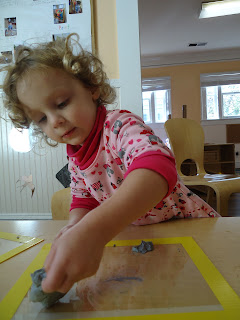"It's almost like dancing, you know. Clay is just a big blob, but the minute you touch a piece of clay it moves. It's plastic. So you have to respond."
- Peter Voulkos, National Museum of American Art (from Children and Their Art, 8th Ed.)
Art that extends into the third dimension opens up an exciting world of possibilities to children. We spent the bulk of the first half of the year working in two-dimensional surfaces, like drawing, painting, and printmaking. Our daily use of play dough, both with tools and without, helped prepare us for the real deal: Clay.
Among the major differences between clay and play dough is the fact that clay is much firmer then play dough. It presents a greater challenge in manipulation, and requires muscles to work harder to control it. Modeling and sculpture take lots of practice, and we encourage our artists to try different things, like patting, poking, and rolling the clay.
We see clay play as an enriching precursor to their elementary school art experiences, where they will learn more about the basic vocabulary of form for clay sculpture: the slab, the coil, and the ball. Freely exploring this material in our class helps them gain familiarity with it and build their artistic repertoire.
 |
 |
 |
 |

No comments:
Post a Comment